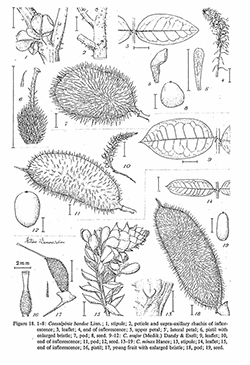e-Flora of Thailand
Volume 4 > Part 1 > Year 1984 > Page 72 > Leguminosae-Caesalpinioideae > Caesalpinia
8. Caesalpinia bonduc (L.) Roxb.wfo-0000214186
Fl. Ind. ed. 2. 2: 362. 1832, pro parte excl. pl. descr.; Dandy & Exell, J. Bot. 76: 179. 1938; Back. & Bakh. f., Fl. Java 1: 545. 1964; Hattink, Reinwardtia 9: 71. 1974: Vidal & Hul Thol, Bull. Mus. natn. Hist. nat. Paris 395 (Bot. 27): 91. 1976; Vidal in Fl. C.L.V. 18: 37. Pl. 5, 1–8. 1980. Fig. 18: 1–8.
Accepted Name : Guilandina bonduc L.
Sp. Pl.: 381. 1753.
Synonyms & Citations :
Description : Climber armed with straight or recurved prickles. Stipules pinnate consisting of 3–5 leaflets up to 2 cm. Leaves: rhachis 30–50 cm; pinnae 3–9 pairs; leaflets 8–12 pairs, opposite or subopposite, petiolulate (0.8 mm), ovate-lanceolate, 2–4 by 1–2 cm, acute or rounded and mucronulate at the tip, unequal at the base. Racemes supra-axillary, sometimes branched, some with ♂ flowers, others with ♀ flowers (anthers without pollen). Bracts linear, 6–12 mm, recurved, lately caducous. Pedicels 4–6 mm, pubescent, faintly jointed near the top. Sepals pubescent, subequal. Petals yellow, the standard constricted and hairy inside towards the middle. Filaments hairy. Ovary ca 1 mm, stalked, hairy and bristly, 2-ovulate, in male flowers rudimentary. Pods stalked above the receptacle (0.5–1 cm), elliptic in outline, 5–8 by 4 cm, set with hairy 7–9 mm long bristles. Seeds 2, subglobular, 15–20 mm, greyish.
Thailand : NORTHERN Chiang Mai; NORTH-EASTERN: Nakhon Phanom; CENTRAL: Krung Thep Maha Nakhon (Bangkok); SOUTH-EASTERN: Prachin Buri, Rayong, Chanthaburi; PENINSULAR: Surat Thani, Trang, Pattani.
Distribution : Pantropic, in Asia from Ceylon to Bonin Islands: Ceylon (type), India, Sikkim, Nepal, Burma, Laos, Cambodia, S & N Vietnam, China (Hainan, Kwangtung), Hongkong, Taiwan, Bonin Islands, Malay Peninsula and Archipelago.
Ecology : Along sea beaches as well as in inland scrub jungle and hedges. Flowering: July–October; fruiting: November–April.
Vernacular : Ba khi haet, ma kaleng (บ่าขี้แฮด, มะกาเลง) Northern); sawat (สวาด)(Central); da-mat (ดามัด)(Malay-Penimular).
Uses: Seeds are like cat’s eyes and used as medicine in India, Malay Peninsular and Archipelago; no such medicinal use reported for Thailand.

